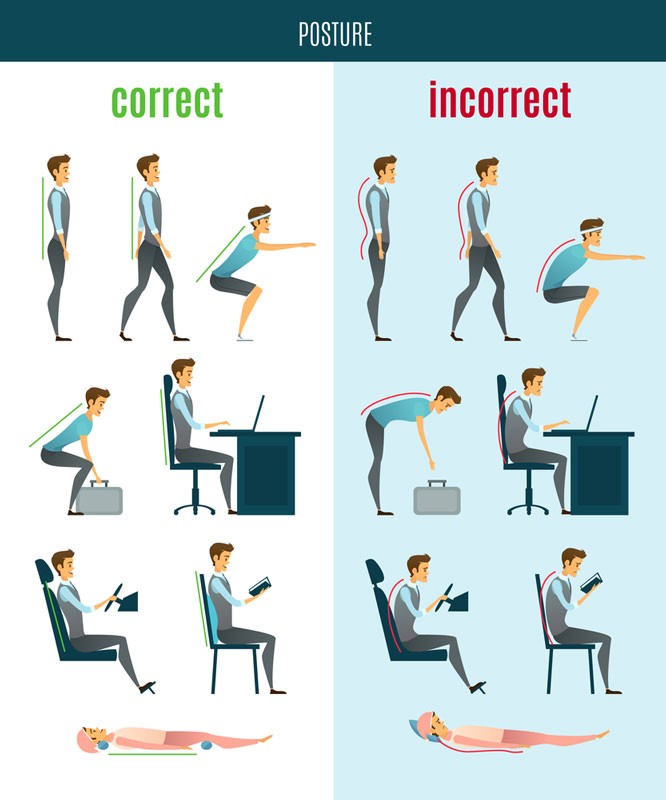Sit up straight! Don’t slouch! Pull your shoulders back! Do you remember being reprimanded as a child for your posture? I certainly do!
During my younger years, it was common rhetoric I would hear.
The science though is not so clear on posture and if indeed it has any bearing on the likes of lower back pain or if it even increases your chances of herniating a disc.
However, it may have a bearing on upper back pain which I will touch on later.
Posture and lower back pain
We used to talk about sitting up straight, pulling our shoulders back and even balancing a book on the top of the head.
It was felt that this was the perfect type of posture and if spend our time slouching around we will develop back pain and other joint ailments.
In a 12-week study published in BMC Musculoskeletal Disorders in 2016, a group of 60 people were given movement sensors that measured the curvature in their spine and the movement in their pelvis as they did five tasks.
Movement versus static posture
The general gist of the current research is that posture variability is much more important, so to be changing postures throughout the day is better for you than remaining in one fixed static rigid posture.
This includes staying in the ram rod straight back book on head posture as well!

Our body is geared to keep us moving and has protective mechanisms in place to tell us when to do so.
This protective mechanism consists of nerve endings called nociceptors, which react to pressure and other inputs such as heat.
When you sit in one position for too long, nociceptors detect the pressure and prompt messages to be sent to the spinal column and brain that mean you feel uncomfortable, which in turn leads to you adjusting your position/posture.
What happens if you don’t adjust your posture?
The problem is everyone has a different threshold for pain response and in today’s world we often find ourselves stuck in the same position for hours throughout the day.
We simply ignore the body’s pain signals.
Now as I mentioned earlier there is very little evidence for lower back pain and posture, however, there is growing eve when it comes to upper back/neck pain.

Have a think about many people’s daily lives now…Nearly half of Americans spend an average of 5 to 6 hrs a day on their phones not including work time!
You then spend the rest of your work day hunched over your laptop working from home and then you sit on your bed hunched over your phone and then you sit on the couch hunched over playing video games….
It has become so bad we have a new term called “tech neck” which relates to what is normally called forward head posture.
What is Tech Neck?
Tech neck, which is also referred to as cervical kyphosis, is a frequently painful condition that results from the hunchback slouch many people employ when they’re using their electronic devices. The issue starts when you bend your neck forward so you can look at your smartphone, tablet, laptop or another electronic device.
When you look straight ahead, the weight of your head is between 10 and 12 pounds. Even if you only bend your neck forward 15 degrees to look at your phone, it doubles the weight of your head, making your head weigh around 27 pounds.
Can you Imagine bending your neck at 45 degrees — that’s almost 50 pounds of weight your neck muscles, upper back and shoulders are supporting.

Your muscles must work harder now because you’re beginning to move the center of gravity forward just a little bit. They’re supporting a heavier head, and this will obviously cause some neck pain.
This can lead to headaches, chronic pain, trouble sleeping and of course a poorer quality of life.
Too many of us do not have enough physical movement to counter these types of movements and positions.
A sedentary lifestyle is not healthy for the body and the same rule applies to your spine.
Posture and weightlifting
Now when it comes to going to the gym, house work, gardening and lifting heavy objects, for example, we do need to be very aware of our posture.

You see once we start to lift heavy objects we increase the loads placed on the joints hence, posture dictates the load bearing ability of joints including most importantly your spine.
This is when the old adage of keep your back straight and lift with your legs comes in.
In fact, I have a really useful video on learning how to hip hinge and pick objects up off the floor below, check it out.
It is also very important to brace your abdominal wall whilst lifting heavy objects such as weights or furniture.
Now the body normally does this automatically as a natural spine protection mechanism but it doesn’t hurt to practice this to ensure you are keeping your spine safe.
Learn abdominal bracing below:
Let me repeat, a sedentary lifestyle is not healthy for the body and the same rule applies to your spine.
How to keep yourself pain free
– If you sit a lot due to work get up once every hour and move around more
– If you stand a lot at work sit down from time to time and actually lean back and relax
– Make sure your work desk is set up correctly to avoid back pain
– If you go to the gym, ensure your spine is held in a stable neutral position when performing exercises such as deadlifts and squats
– Keep your core strong which can help to stabilize your spine during activities – you can check out some beginner exercises below
Conclusion
Forget trying to find the perfect posture if you’re experiencing pain associated with posture; step back and analyze the positions you sit, stand, walk, or exercise in daily.
You first need to understand what has brought about the pain and why it hurts and then formulate a plan of attack to overcome that pain and a change in static or standstill posture is a must.
If you would like more useful back pain healing tips you can sign up for my weekly back pain recovery emails here.

